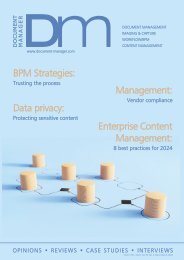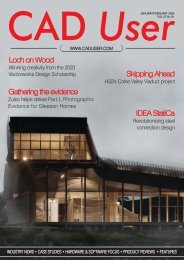CU Sep-Oct 2023
Create successful ePaper yourself
Turn your PDF publications into a flip-book with our unique Google optimized e-Paper software.
TECHNOLOGY focus<br />
both accurately and intact.<br />
The building of the AIM will also be further<br />
complicated if a number of sensors are<br />
being used - perhaps to provide the<br />
facilities for a digital twin of the project, for<br />
example - creating a super CAFM that<br />
constantly monitors the IoT and updates<br />
the AIM database. But this is a facility that is<br />
not yet available, as it would require the<br />
data to be provided in different standards<br />
by different members of the supply chain.<br />
Would the information actually be in the<br />
PIM or would it be compiled once the<br />
sensors and their software solutions are<br />
installed on the AIM solution?<br />
THE IMPORTANCE OF AC<strong>CU</strong>RACY<br />
Having extracted what you need from the<br />
PIM, assembled it in a secure, single<br />
source cloud-based environment, instead<br />
of being stored in different locations, on<br />
separate document management systems,<br />
or even, indeed, on personal storage<br />
devices, it needs to be accessible in realtime<br />
to everyone in your team that needs to<br />
use that data, and not to treat cloud-based<br />
storage as just another storage device.<br />
Drawings, models, documents and<br />
schedules, etc. need to be quickly available<br />
and simple to find.<br />
Managing and updating the information<br />
held in the AIM is a priority for the Facilities<br />
Manager. Poor documentation practices<br />
will result in maintenance teams working on<br />
outdated and superseded information,<br />
impacting on the building's efficiency by<br />
extending downtime spent on repairs whilst<br />
maintenance engineers scramble to find up<br />
to date information. Much worse, it could<br />
create unnecessary compliance risks.<br />
Rules and procedures need to be put in<br />
place, and everyone must be made aware<br />
of the importance of updating documents,<br />
including small upgrades and whenever<br />
new equipment is introduced. The<br />
accuracy of the information is paramount.<br />
Originally it was intended that the<br />
information that was required for the AIM<br />
CAFM system was to be delivered using<br />
COBie. It was assumed that serial clients<br />
would already have a CAFM system in<br />
place and all they needed to do for their<br />
Asset information Requirement was to<br />
look at that CAFM system and extract a<br />
list of requirements.<br />
COBie is a major problem, however,<br />
because each client's Asset Manager,<br />
would have to compile their requirements<br />
and produce a project specific COBie<br />
template. A comment raised at a recent<br />
international group meeting suggested that<br />
you need to compile this very carefully so<br />
that you only buy the slice of pizza you<br />
need rather than buying the whole pizza.<br />
BUT WHO OWNS THE DATA?<br />
The Asset Manager might have control over<br />
the AIM and the information it contains, but<br />
the source of that data remains the<br />
intellectual property of the companies<br />
supplying it. It's not just a storage issue.<br />
The building model is the intellectual<br />
property of the originators of that<br />
information, which, because of its nature, is<br />
multidisciplined. If you want to add an<br />
extension to the building, it can't be done<br />
without reference to the original 3D models<br />
and whoever holds the data. The MEP<br />
system supplier, for instance, must ensure<br />
that the building and its contents comply<br />
with current building standards and<br />
regulations by informing the Asset Manager<br />
when new compliance requirements are<br />
put in place.<br />
The responsibility for handling information<br />
needs to be defined, and is everyone's<br />
responsibility, whether it concerns<br />
Government policies, methodologies,<br />
documentation standards, CAD<br />
applications and file formats templates,<br />
version control and, most importantly,<br />
checking and approval procedures for<br />
publishing up-to-date information.<br />
This may also require the renaming of the<br />
files to show ownership during the AIM<br />
period, with appropriate audit trails for new<br />
fire regulations, called the Golden Thread -<br />
as recommended by Hackitt's Building<br />
Safety Bill which introduces the concept as<br />
a tool to manage buildings as holistic<br />
systems. This allows people to use<br />
information to safely and effectively design,<br />
construct and operate their buildings<br />
across their lifecycle - even after ownership<br />
has changed hands.<br />
And we haven't even discussed<br />
standards, such as ISO 19650, BS EN ISO<br />
19650, BS EN ISO 19650, the National<br />
Annex or the BIM Framework, which<br />
suggests in the latest BIM 'mandate' that<br />
projects in the UK should be compliant with<br />
their guidance document. Or, indeed,<br />
whether they are even ISO compliant - or<br />
part of a global standard!<br />
<strong>Sep</strong>tember/<strong>Oct</strong>ober 2022 23

















